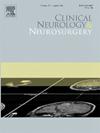绘制胶质母细胞瘤诱导的神经功能缺损:脑图谱
IF 1.8
4区 医学
Q3 CLINICAL NEUROLOGY
引用次数: 0
摘要
背景:识别胶质母细胞瘤患者与神经功能缺损相关的影像学特征和脑区可以提高诊断评估和了解该疾病对神经功能的影响。方法对527例新诊断的胶质母细胞瘤患者进行回顾性研究。入选标准包括病理证实的idh野生型胶质母细胞瘤,造影前和造影后mri的可用性,以及详细的神经学检查报告。对比增强肿瘤(CET)和非对比增强病变(NEL)从3次特斯拉MRI扫描中分割。使用Mann-Whitney试验或Kruskal-Wallis试验比较无神经功能缺损患者的病变体积。采用fisher精确检验和随机排列分析(ADIFFI)对体素级病变症状进行映射,以确定缺陷相关病变发生率较高的大脑区域。结果CET和NEL在脑内的位置与特定的神经功能缺损有关。较大的CET和NEL容量与神经功能障碍增加相关(CET: rs = 0.15, p = 0.0006;NEL: rs = 0.22, p <; 0.0001)。无神经功能缺损患者的病变体积较小(CET: 4.97 ± 0.69 ml vs. 20.0 ± 0.9 ml, p <; 0.0001)。癫痫相关病变也较小(CET: 4.59 ± 0.55 ml vs. 22.0 ± 0.9 ml, p <; 0.0001)。结论该研究强调治疗前的神经和癫痫状态可以估计胶质母细胞瘤病变的体积和位置。病变体积与神经功能缺损之间的相关性强调了对胶质母细胞瘤患者进行全面放射学评估的重要性。这些发现支持使用详细的病变症状映射来指导胶质母细胞瘤的临床管理和预后评估。本文章由计算机程序翻译,如有差异,请以英文原文为准。
Mapping glioblastoma-induced neurological deficits: A brain atlas
Background
Identifying radiological characteristics and brain regions associated with neurological deficits in glioblastoma patients can improve diagnostic evaluation and understanding of the disease’s impact on neurological function.
Methods
The retrospective study included 527 newly diagnosed glioblastoma patients. Eligibility criteria included pathologically confirmed IDH-wild type glioblastoma, availability of pre- and post-contrast MRIs, and detailed neurological examination reports. Contrast-enhancing tumors (CET) and non-contrast-enhancing lesions (NEL) were segmented from 3 Tesla MRI scans. Lesion volumes from patients without neurological deficits compared with symptomatic patients using either the Mann-Whitney test or Kruskal-Wallis test. Voxel-wise lesion-symptom mapping was conducted using Fisher-exact-test followed by random permutation analysis (ADIFFI) to identify brain regions with higher occurrences of deficit-associated lesions.
Results
Location of CET and NEL within the brain were associated with specific neurological deficits. Larger CET and NEL volumes were associated with increased neurological deficits (CET: rs = 0.15, p = 0.0006; NEL: rs = 0.22, p < 0.0001). Lesion volumes were smaller in patients without neurological deficits (CET: 4.97 ± 0.69 ml vs. 20.0 ± 0.9 ml, p < 0.0001). Epilepsy-associated lesions were also smaller (CET: 4.59 ± 0.55 ml vs. 22.0 ± 0.9 ml, p < 0.0001).
Conclusion
The study highlights that neurological and epilepsy status at pre-treatment provide estimates of glioblastoma lesion volumes and locations. The correlation between lesion volumes and neurological deficits underscores the significance of comprehensive radiological assessments in glioblastoma patients. These findings support the use of detailed lesion-symptom mapping to guide clinical management and prognosis evaluation in glioblastoma.
求助全文
通过发布文献求助,成功后即可免费获取论文全文。
去求助
来源期刊

Clinical Neurology and Neurosurgery
医学-临床神经学
CiteScore
3.70
自引率
5.30%
发文量
358
审稿时长
46 days
期刊介绍:
Clinical Neurology and Neurosurgery is devoted to publishing papers and reports on the clinical aspects of neurology and neurosurgery. It is an international forum for papers of high scientific standard that are of interest to Neurologists and Neurosurgeons world-wide.
 求助内容:
求助内容: 应助结果提醒方式:
应助结果提醒方式:


